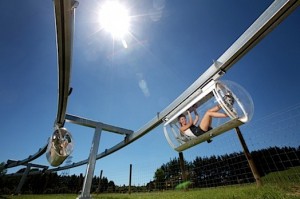 An Inhabitat post this week pointed outs that Google is investing $1 million in Shweeb, a company working on a pedal powered monorail system. The company was selected as the “innovation in public transportation winner” in Google’s Project 10100 program, which aims “to change the world by helping as many people as possible.”
An Inhabitat post this week pointed outs that Google is investing $1 million in Shweeb, a company working on a pedal powered monorail system. The company was selected as the “innovation in public transportation winner” in Google’s Project 10100 program, which aims “to change the world by helping as many people as possible.”
 Shweeb has been working on these pedal powered monorail pods for a while now. The New Zealand based company was founded in 2006, and you may have seen pictures of their two 200meter long test tracks before. The idea of a bicycle monorail system goes back well beyond 2006 though. In 1892, The Hotchkiss Bicycle Railway, invented by Arthur E. Hotchkiss, was built from Mount Holly to Smithville in New Jersey. According to Unusual Pedal Bicycles, the bicycle railway was not a success, and the company filed for bankruptcy in 1898. Let’s hope that with the infusion of money from Google, Shweeb can last longer than Hotchkiss did. It’s certainly an idea that I would love to see implemented (again).
Shweeb has been working on these pedal powered monorail pods for a while now. The New Zealand based company was founded in 2006, and you may have seen pictures of their two 200meter long test tracks before. The idea of a bicycle monorail system goes back well beyond 2006 though. In 1892, The Hotchkiss Bicycle Railway, invented by Arthur E. Hotchkiss, was built from Mount Holly to Smithville in New Jersey. According to Unusual Pedal Bicycles, the bicycle railway was not a success, and the company filed for bankruptcy in 1898. Let’s hope that with the infusion of money from Google, Shweeb can last longer than Hotchkiss did. It’s certainly an idea that I would love to see implemented (again).

Leave a Reply to andy Cancel reply